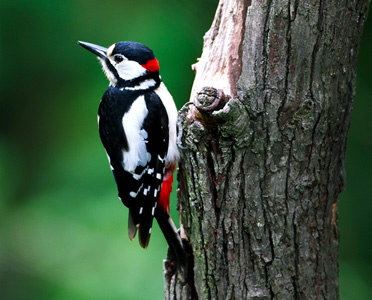These birds are sometimes difficult to see, but are more often heard.
The Great Spotted Woodpecker
is usually located by its “tchik” call, but can be very noisy when chasing, and also when drumming in the spring. Just now they are breeding and the youngsters can get very impatient waiting for their parents to return with food. They gather around the nest entrance hole and keep up a continuous cheeping racket (this is a good way to locate the nests – usually high up). However, if the returning parent spots you it will give a quick call and the young stop calling.

The Green Woodpecker’s nest is more difficult to find, but the adult birds’ liquid “yac-yac-yac” cry is particularly distinctive. It doesn’t make a fast drumming like the Great Spot, but of course you can hear it hacking away at the bark searching for insects. It feeds on the ground more often than the Great Spot (you may have them visit your garden in search of ants).
The Lesser Spotted Woodpecker really is ‘lesser’, being about the size of a sparrow. Being so small it can feed in the topmost tree branches and so is harder to find. This difficulty is increased by the bird being very quiet, except during the breeding season, when you might be lucky and hear its ringing “keekeekeekee”. This is certainly the most scarce of our woodpeckers, but it was not always so. In the “Birds of Middlesex” by JE Harting published in 1866 he says of the Lesser Spotted Woodpecker “In this county of more frequent occurrence than the Greater Spotted, or even the Green Woodpecker”. A few years ago several nests were located in the middle of Park Wood and in the Nature Reserve. Recently there have been fewer records suggesting a real decline.
As with the woodpeckers the Nuthatch’s call helps to locate it, but it is not a shy bird and is easily spotted running up and down (head first) the trunks and branches of the oaks. Although living in the trees like the woodpeckers it is not related to them. It actually resembles a rather dull Kingfisher, but is not related to them either. Unlike the woodpeckers it does not excavate a nesting hole. It uses a convenient ready-made hole and cunningly plasters the entrance with mud leaving a hole just sufficient for getting in and out. It is very much a woodland bird and is not often seen in gardens away from the woods.
British Trust for Ornithology Woodpecker Identification
Colin Bowlt- 29.5.15
